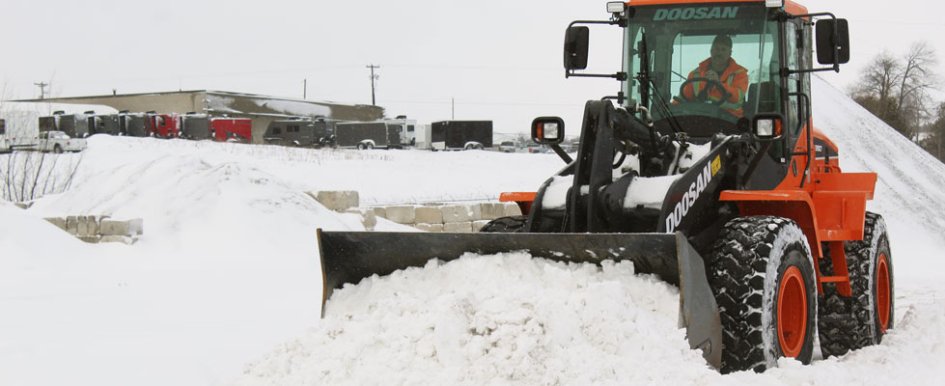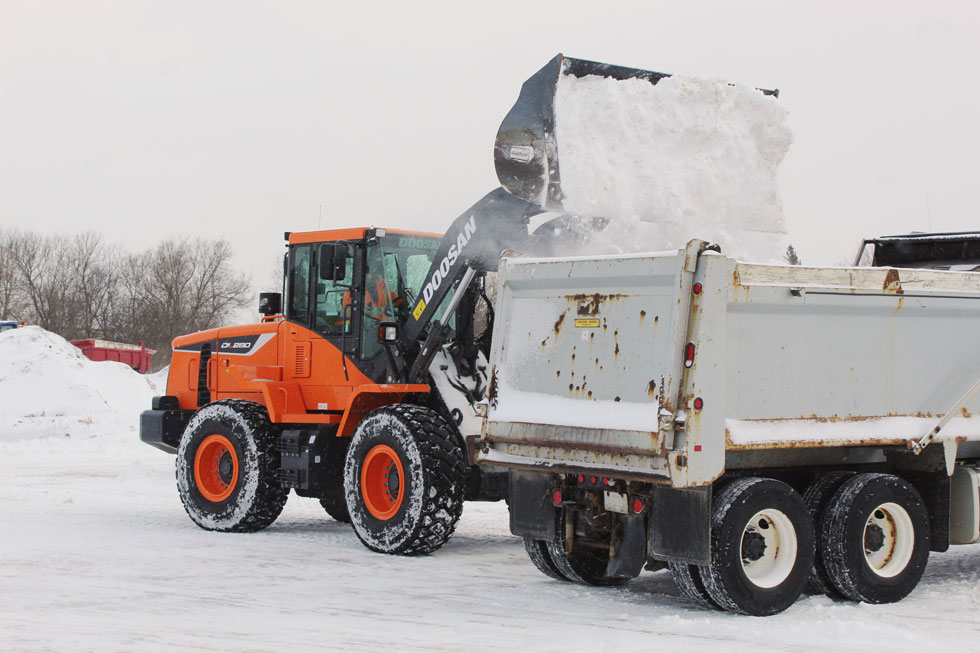
An idle machine can be painful. Whether you are an operator or owner, reducing machine downtime is always a good goal. If you own a wheel loader and want to extend its use throughout the year, consider clearing snow.
Winter provides an opportunity to use your wheel loader in your traditional offseason. When deciding to use your wheel loader in snow removal, there are several factors to consider. Keep the following in mind when deciding if you will operate your wheel loader during the offseason and make the most of winter.
Determine Your Snow Strategy
Before thinking about using your wheel loader for snow removal, it is smart to start with the basics.
- What type of work does your machine perform during the busy season?
- Do you have a construction business that is looking to add more work in winter?
- Will you start a dedicated snow removal division?
- Will your busy-season employees work during winter?
- Are they trained to clear snow?
Recognizing your priorities for your wheel loaders will help you move forward. It is wise to consider the following factors to decide what configuration will work for you and your team.
It’s All in the Attachments
Your wheel loader will give you the power to move snow, but just as important is the way you go about moving it. This is where your equipment attachments come in. There are a lot of considerations when deciding which attachments to pair with your wheel loader for snow removal.
If you are thinking of using a bucket, make sure you have one appropriately sized for snow removal. The standard bucket that comes with most wheel loaders is not the ideal tool for this job. They generally don’t have a large enough capacity and lack the optimal width to work efficiently and effectively. If you add a snow removal bucket, look for a wider, light-material bucket. This will speed up the job and improve your operator’s productivity.
Your attachment choice also depends on the environment in which you will be working. Having a large, wide bucket is great for moving or loading large amounts of snow, but it can also be harder for your operator to maneuver. It is smart to evaluate what kind of area you will be clearing and adjust to those criteria.
If you are fortunate to have a wide-open parking lot, then a snow pusher is a good choice. You can quickly push snow off parking lots at businesses, shopping malls and grocery stores. If you are working in a set development or clearing roadways, then an angle blade can be more appropriate.
If you are considering attachments besides buckets, think about blades, snow pushers or a self-powered snowblower. What are their advantages? A V-blade can give you versatility—maneuvering it like a bucket or using it to push and move the snow. If you have a hydraulic quick coupler on your wheel loader, a snow pusher can offer the versatility to use your machine in different steps of snow removal. A snowblower is another option to consider. It can be attached to the front of your wheel loader to throw snow off the roadway. The snowblower is powered by a separate engine.
 Maintaining Your Machine
Maintaining Your Machine
Winters can be hard on construction equipment, regardless of its purpose. It is important to maintain your regular maintenance and put in some extra care during your daily machine walkarounds.
Extreme cold can impact equipment in different ways than you’re typically used to in temperate seasons. Keep an eye on hoses, wear points and articulation joints for any accumulated snow and ice.
Another key to keeping your machine functioning smoothly in the cold is staying on top of the fluids. Any time your wheel loader is idle, whether that be overnight or for a week, keep fluids topped off. That includes diesel fuel and diesel exhaust fluid. If you encounter a longer snow event or you have to work through the night, you will be glad your team kept those fluids top of mind.
Location Matters
To help reduce unnecessary wheel loader wear, store it in a location where it is protected from the elements. In a perfect situation, store the machine in a climate-controlled, easily accessible facility. Unfortunately, that is often not an available option. How to balance accessibility and machine protection is a decision each operator will have to make. Snow happens at Mother Nature’s will, so easy access to your wheel loader is important. You might have to clear snow at midnight, noon or both. Storing your wheel loader near where you will be moving snow helps keep operations efficient. Many facilities even keep the wheel loader stationed on-site during the snow season.
If you store your wheel loader at a climate-controlled location where you can plug in an engine block heater, your machine will be ready to go when you are. If you keep your wheel loader in a location where you don’t have access to consistent power, consider adding a diesel-powered coolant heater. It will heat the coolant in the engine and help maintain the engine for easier starts in colder climates.
If you can’t store your wheel loader inside, be diligent in checking to make sure there isn’t snow and ice in areas of the machine that can impact its functionality. It’s an additional step in your workflow to check and remove those winter obstacles, but it will help keep your machine in working order.
Special Considerations
Consider how the timing of snow clearing will affect your work. For example, hospitals have visitors, staff and patients coming and going at all hours. Will you have to work around their vehicles?
Other public places, such as malls, have more defined hours. You’ll likely need to be there early in the morning and have the lot cleared for business when customers arrive. Many snow removal contractors work at night to clear roads and parking lots. If you’re frequently working at night, it is worthwhile to consider installing additional lighting on your wheel loader.
You can purchase work lights to give yourself extra visibility and make yourself more visible to other machines and vehicles. A rotating beacon or flasher is a wise investment to increase operator safety. Check local requirements to ensure your wheel loader is properly equipped for clearing snow.
There is a lot to consider in preparing to take on winter work, but it can prove to be worth it. Not only does it tap a new revenue source, but it also makes good use of your equipment year-round.
